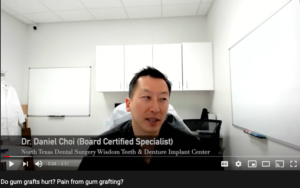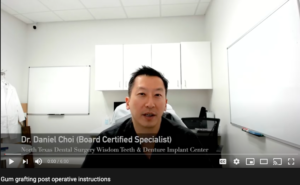Failed Gum Graft
Of the many different different types of dental surgical procedures, gum grafts have a higher chance of failure. However, when done with an experienced and knowledgeable periodontist, you will have the highest chance of gum graft success. When researching a periodontist, try to find somebody who has a lot of photographic examples of their personal before and after results. In my experience, although this is a procedure most commonly done by a periodontist, not every periodontist is equal in attaining the desired surgical results.
How do I know if I have a failed gum graft?
Usually, you can tell you have a failed gum graft because you will have a large white patch of white tissue that has come off the tooth. Sometimes it may even look like the gum graft is falling off. The reason it is white is that the transplanted tissue has lost its vascularity (blood supply) and therefore the tissue has died. If the tissue is hanging outside your tooth, you will need to go see your periodontist immediately so they can assess what the next stage may be. Sometimes it may be best to allow the tissue to remain there to continue to let the gums heal in the surrounding area. Other times, it may be essential to just remove the dying gum graft immediately and allow the surrounding gums to heal on its own.
Why did my gum graft fail?
That’s a tough question to answer but there’s usually one of two main causes. Either it was a surgical error or you did not do a good enough job following the post-surgical instructions. This procedure is very technique sensitive and requires that your periodontist be highly skilled and experienced at doing this procedure. However, it is also very important that you follow your post-surgical instructions very carefully. This procedure involves a transplant of tissue and its imperative that you don’t move your gums by not being careful about how you brush and eat.
Gum graft infection
One last possibility on why your gum graft failed is that your gum graft became infected somehow. One way to truly tell if you have an infection is that you will see pus coming from the graft site. This will look like a thick yellow fluid that is leaking from the surgical site. It is important to make sure to take antibiotics during the healing process to help prevent infection. If you already have an infection and then try to take antibiotics afterward, it is unlikely that you will have a successful result.
What should I do after a failed gum graft?
You can always reattempt to have your gum graft redone. You need to wait at least 3 months after your failed gum graft to make sure the tissues have properly healed and matured after your initial surgery. An attempt to redo a gum graft too soon won’t allow you to have the most optimal response. If you’ve had several failed gum grafts, it will be difficult to get the best result due to a buildup of excessive scar tissue. Make sure you seek a second opinion on whether a reattempt would be in your best interest. Another important factor to consider is if you’ve had several failed gum graft attempts with human donor tissue such as alloderm, it might be best to reattempt the procedure with your own tissue because it tends to give more predictable results due to the fact that it’s your own tissue.
In Summary
- Gum grafting is very technique sensitive. Make sure you find a highly skilled periodontist to do your gum graft
- Make sure you follow your post-surgical instructions VERY CAREFULLY!
- You will know if you have failed gum graft because the graft will be very white. Immediately see your periodontist see what the next step is.




